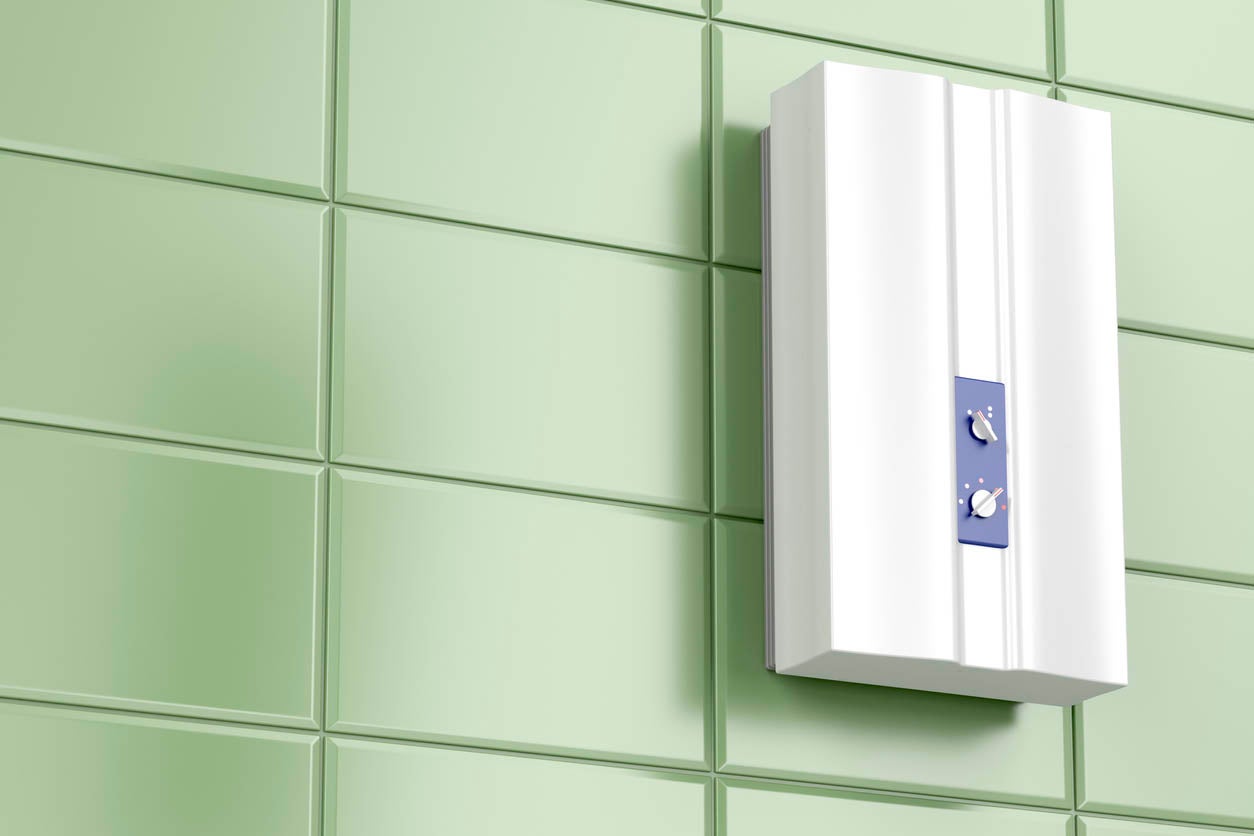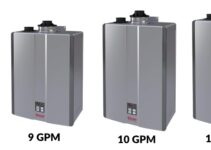Are you looking for an energy-efficient and cost-effective way to heat your water? Consider investing in a gas tankless water heater.
Learn how these units work and their numerous benefits in this comprehensive guide. You won’t regret it!
A tankless water heater, also known as a demand-type or instantaneous water heater, is a more efficient heating solution than the traditional water heater found in many homes. As its name implies, this type of system does not store heated water in a container. Instead, it only heats and supplies warm water when necessary. This allows such a system to save significant amounts of energy compared to traditional storage models and can be an economical choice for busy households.
This guide will cover the basics of tankless water heaters, including the types available, their typical features and benefits, maintenance tips, and the common problems associated with them. By understanding how this type of heater functions and determining whether it is right for your household’s needs, you can make an educated decision about whether or not it is the right option for your situation.
Definition of gas tankless water heaters
Gas tankless water heaters are a type of water heater that does not use a storage tank. Gas-fired tankless water heaters can provide hot water on demand, eliminating the need for a storage tank of water that is continually heated. This type of water heater does not continuously burn gas like traditional gas-fired storage water heaters do. Instead, it uses a progressive ignition system that ignites the burner only when hot water is needed. In general, these units are powered by natural gas or propane, although some electric versions are available from certain manufacturers.
Gas tankless water heaters use high-powered burners to rapidly heat incoming cold water supplied through the system’s pipes. As the cool supply of incoming water passes through the system’s internal exchanger coil, gas is burned quickly and efficiently to instantly heat the flow of cold liquid before it enters your home’s plumbing system. When there is no more demand for hot water, the unit automatically shuts off, conserving energy and eliminating wasted fuel consumption and cost associated with traditional style tanked units which often times allow cool air heated more than once during its cycle in order to maintain temperature stability within its reservoir tank.

Why gas tankless water heaters are becoming more popular
Gas tankless water heaters are growing in popularity for a variety of reasons. Aside from their energy efficiency, gas tankless water heaters offer convenience and space savings. Gas tankless water heaters require less space than a traditional storage water heater because it does not contain any tank — meaning it can be installed in tight spaces, such as closets or garages. Convenience is another reason why gas tankless Heat pumps become the choice of many homeowners. It operates on demand, meaning that hot water is available at all times without the need to wait for it to heat up before emerging from the fixtures.
Gas powered tankless water heaters also have far better energy efficiency than storage type models and can reduce your energy bill each month by up to 40%. Unlike traditional storage water heaters, which must continually operate and use energy to maintain a store of hot water in its own reservoir, with gas-powered tankless systems heating is only activated when you trigger a hot-water faucet or appliance; thus greatly reducing energy consumption. Because there’s no reservoir of heated water sitting idle between uses, the amount of wasted energy emitted from the unit is almost negligible.
How Gas Tankless Water Heaters Work
Gas tankless water heaters are becoming more popular among homeowners due to their many advantages, such as energy savings, hot water on demand and the eco-friendliness of gas. But how do they work?
Gas tankless water heaters use a combustion process to heat the incoming cold water. This is done by burning a fuel source, usually natural gas or propane, in a combustion chamber located inside the heater. This fuel is ignited by a spark from an electric ignition system known as an “ignitor”. The combustion process produces heated gases which travel through a heat exchanger where they are cooled and become harmless. The cooled gases then pass out through an exhaust vent while transferring their heat to the incoming cold water which is continually supplied by your home’s plumbing system.
The cold water continues through the inside of the heat exchanger until it reaches the desired temperature, determined by you with your thermostat settings. It is then sent through pipes that it exits out at both faucets and shower heads all over your house once you turn them on. Gas tankless systems only produce hot water when needed so they don’t save energy by keeping large quantities of hot water in storage like traditional tank-style gas or electric water heaters do; rather they produce only what is required when it is needed thus saving considerably in energy costs compared to other units that must continuously store and re-heat large volumes of hot water over long periods of time while it waits for you to use it.
Overview of the gas tankless water heating process
A gas tankless water heater is a great option for many homeowners seeking an energy-efficient, on-demand hot water solution. The process of controlling and delivering hot water for use in your household is known as the “tankless” system. Instead of storing large amounts of pressurized hot water in a tank, this system heats up only the needed amount directly from your gas line and produces it when it’s demanded – i.e., when a faucet/shower or washing machine is turned on.
In tankless systems, cold water runs through a series of water lines leading to the main heating unit. Here, in most cases, it passes through an electronic controller controlled by thermostat settings set by you according to their needs and turns the gas burner element or electric heating element on when there’s a demand for hot water. Once turned on, cold water enters the unit and gets heated between 110 degrees Fahrenheit to 150 degrees Fahrenheit and flows at up to 8 gallons per minute depending on model used with constant temperature until the tap shutoff valve gets turned off.
The most common solid fuel used for this type of heating process involves natural gas or propane; however, solar power usage has also become popular particularly in warmer climates due to its advantages over conventional cooling methods. Gas tankless systems come in different sizes ranging from small residential units that specifically address only certain taps such as showers or washing machines, to larger scale whole house models that supply large amounts of hot water needs within the home with enough pressure suitable for high flow shower outlets and washing machines.
Components of a gas tankless water heater
A gas tankless water heater contains a variety of components that work together to heat your water.
The main components of a gas tankless water heater include:
-The heat exchange unit that heats water passing through the tubing in the unit. This is typically a copper and/or brass material, and can be connected directly to the gas line.
-The vent system, which includes a flue pipe, vent terminations and other fixtures needed to ensure proper ventilation of the exhaust gases away from your home or business.
-The burner assembly, which typically consists of an electrical ignition system and an adjustable flame size control that allow you to program the correct temperature for your application.
-The electronic control board regulates all operations including providing diagnostic information if required.
-Gas pressure regulator maintains ideal operating pressure within the system regardless of changing atmospheric conditions or incoming gas supply pressures.
-Safety sensors, like high temperature shutoffs or sensing devices for detecting leaks in the system’s connections are also included with many systems as additional safety features.
How gas tankless water heaters differ from traditional tank water heaters
Gas tankless water heaters, also known as on-demand water heaters or instantaneous water heaters, provide hot water without the use of a storage tank. Unlike traditional tank water heaters that continuously store and reheat a certain amount of hot water in a tank, on-demand models use highly efficient burners to quickly heat up cold water as needed.
This type of system offers several advantages over traditional tank models:
Energy Efficiency – Tankless systems don’t have to keep a large volume of hot water pre-heated in storage so they are much more energy efficient than traditional units. They also require less space since there is no bulky storage tank taking up valuable space.
Continuous Hot Water – Since there is no preheating necessary, hot water is available any time you need it with an endless supply of hot water for those long showers or multiple users simultaneously.
Lower Initial Cost – Although the total cost savings depends on how often and how much hot water you use, gas tankless systems generally provide an initial cost savings by not having to purchase a large metal tank.

Installation and Maintenance of Gas Tankless Water Heaters
The installation of a gas tankless water heater can involve a bit more work than simply plugging in an electric tankless unit, as it needs to be linked to the home’s gas supply. It is always recommended that this work be done by a qualified technician, as working with natural gas can be hazardous.
Once installed, the maintenance of a gas tankless water heater is relatively simple and will involve regular inspection of the venting system, checking for carbon monoxide leakage and checking for problems with the appliance components.
The burner should be checked at least once every few months and cleaned if necessary, while anode rods should also be inspected regularly. Most manufacturers also recommend replacing them every two years or so depending on water quality. The heat exchanger should also be examined at least one per year and any corroded parts replaced if necessary.
Installation process
Installing a gas tankless water heater requires very specific expertise to ensure that the unit is safely and securely mounted. Gas tankless water heaters require venting—either through the roof or out an exterior wall of the home. The process of running this piping is complex, especially if you are venting through a wall instead of the roof. When installing a gas tankless water heater, be sure to work with a qualified professional who has experience with gas units to ensure that it is done correctly and safely. While many can install these units themselves, there are distinct safety risks associated with gas appliances and working with an HVAC expert can prevent potential disasters down the line.
In addition to these specific installation requirements, many localities have codes and regulations that must be followed for comfort and safety purposes. A proper install will take into account ventilation needs, insulation requirements, and other related issues before any unit is mounted on your wall or in your closet or attic. Proper placement near air vents ensures that your equipment achieves proper air flow as needed its parts are not exposed to harmful exterior elements such as rain or snow (if outside). Installing an improper or unauthorized unit could leave you vulnerable to expensive repairs down the line when the unit fails too soon due to improper installation practices.
Maintenance requirements
Gas tankless water heaters require more maintenance than traditional units due to the fact that they are powered by gas. Gas water heaters should be serviced regularly to ensure that the fuel, ventilation, and combustion components are all functioning properly. The frequency of service for your specific heater may depend on the manufacturer’s suggested intervals, local codes or ordinances, and other factors.
It’s important to check with a qualified service technician yearly to check for any issues with your system and make sure it’s running optimally. During the inspection, they will inspect all fuel lines, venting pipes, valves, and seals; remove any sediment buildup; clean or replace filters as needed; adjust gas pressures; tighten all electrical connections; and test the thermostat accuracy. They may also inspect safety devices such as flue shut-offs or high-temperature limits, which might be installed in some systems.
A professional technician may also advise you on how best to balance performance and efficiency within your home’s hot water system.
Common issues and troubleshooting tips
Gas tankless water heaters rely on a complex system of natural gas, air and water to get the job done. While tankless systems last much longer than their traditional tank counterparts, occasionally they’ll develop an issue or two requiring either repair or replacement. The following guide will help you diagnose common problems and provide recommendations on how to address them.
Water Pressure: One of the most common issues with gas tankless water heaters is insufficient water pressure or varying temperatures. The first step when troubleshooting should be to check the inlet pressure valve setting to ensure that it has been adjusted properly (usually between 30-45 psi). Adjusting the inlet pressure will both reduce the risk of scalding, as well as maximize performance; certain models may require additional precautions such as installing a thermal expansion tank.
Exhaust Blockage: Another commonly encountered problem is that of exhaust blockages caused by lint build-up or other debris trapped in the vent pipe. This can cause a decrease in hot water production and result in damage to your heater over time if not addressed promptly. To avoid this issue from occurring, it’s recommended that owners regularly inspect their vents for proper functioning once every few months. Additionally, a periodic cleaning can help keep your heater running smoothly and prevent blockages from forming.
Leaking Connections: Lastly, another issue that is frequently seen with gas tankless heaters is leaking connections between the tubing and valves due to improper installation procedures or loose fittings. In such cases, it’s necessary to tighten all connections according to manufacturer instructions, ensuring no undue stress is being put on any part of the system so as not to compromise its integrity overall.

Conclusion
Overall, gas tankless water heaters provide great energy efficiency, convenient installation and space-saving solutions. They do come with some drawbacks, such as the upfront cost and quick (and loud) water flow at start-up, but the potential benefits far outweigh any such cons.
With good maintenance and care from time to time, a gas tankless water heater will likely give you a steady supply of hot water for years to come at a long-term cost that is lower than most standard tank models. Investing in a tankless water heater will not only save you money in the long run but also provide environmental benefits via reduced energy consumption.
FAQ’S
Is a tankless water heater better on gas?
Yes, a tankless water heater is better on gas because it only heats water on-demand, which reduces energy consumption and gas usage compared to traditional tank water heaters.
What are the pros and cons of a tankless gas water heater?
Pros of a tankless gas water heater include energy efficiency, space-saving design, and on-demand hot water. Cons include higher upfront cost, potential for flow rate limitations, and the need for proper venting.
What are the drawbacks of a tankless water heater?
Drawbacks of a tankless water heater include higher upfront cost, potential for flow rate limitations, and the need for proper venting and maintenance.
What is considered the biggest advantage of a tankless water heater?
The biggest advantage of a tankless water heater is its energy efficiency, which can result in lower energy bills and reduced carbon footprint.
What are two advantages of a tankless water heater?
Two advantages of a tankless water heater are energy efficiency and on-demand hot water.
Are gas tankless water heaters safe?
Yes, gas tankless water heaters are safe when properly installed and maintained.
Does a gas tankless water heater use a lot of electricity?
Gas tankless water heaters do not use electricity for heating, but may require electricity for ignition and control functions.
What tankless water heater is better gas or electric?
The choice between gas or electric tankless water heaters depends on your specific needs and circumstances. Gas may be better for higher hot water demands, while electric may be more efficient for lower hot water demands.
Where is the best place to put a gas tankless water heater?
The best place to put a gas tankless water heater is in a well-ventilated area with proper gas and electrical connections, and sufficient space for maintenance and service.
Do tankless water heaters need maintenance?
Yes, tankless water heaters require periodic maintenance, such as flushing the unit to remove mineral buildup and checking the venting and gas connections.
See Also:
- Best 80 gallon electric water heater
- Best 110 volt tankless water heater for shower
- Best electric tankless water heater
- Best electric tankless water heater for rv
- Best electric tankless water heater for whole house


